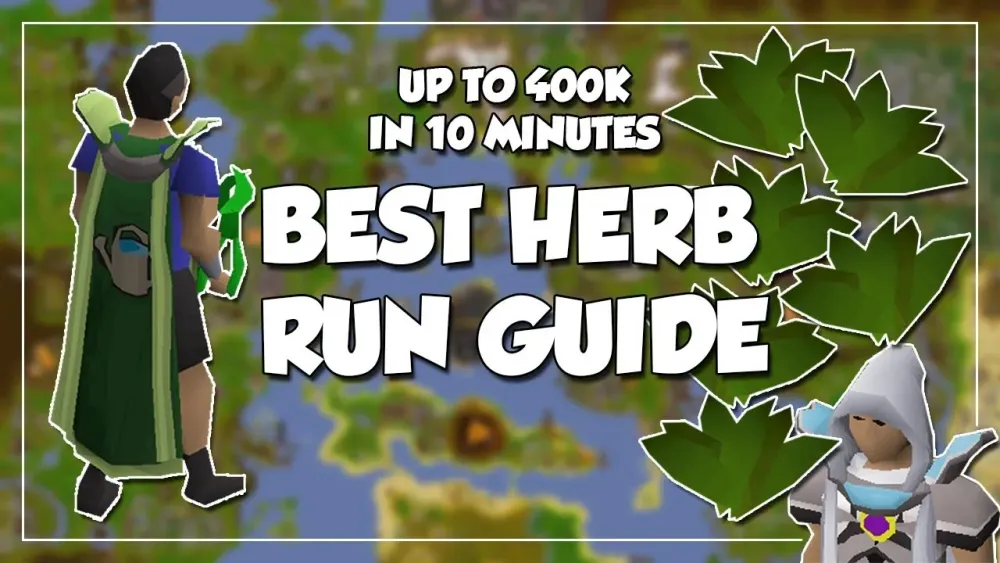Your cart is empty
The Most Profitable Herb Runs in OSRS: A Comprehensive Guide

Herb runs in Old School RuneScape (OSRS) offer players a consistent and lucrative method for generating gold and obtaining valuable resources. By cultivating various herbs and utilizing efficient farming techniques, players can maximize their profits while enhancing their gameplay experience. This comprehensive guide will delve into the essentials of herb runs, including their profitability and the best practices to implement for optimal results.
Herb runs in OSRS are considered one of the most profitable activities due to several key factors. Firstly, the herbs harvested can be used for potion-making, which is a highly sought-after skill in the game. The demand for potions such as Saradomin brews, Super restores, and Prayer potions ensures that the herbs have a steady market value. Players can either sell the raw herbs directly or process them into potions, significantly increasing their profit margins.
Another factor contributing to the profitability of herb runs is the relatively low initial investment compared to other money-making methods. The seeds required for herb farming can be purchased or obtained through various means, often at a low cost. Moreover, the farming process requires minimal attention, allowing players to engage in other activities while waiting for their herbs to grow. With a little planning, players can set up multiple herb patches across Gielinor, thereby maximizing their yield per hour.
Additionally, certain herbs are more profitable than others, and understanding which ones to grow is crucial for maximizing earnings. For example, high-level herbs like Torstol and Ranarr are known for their higher market prices, making them preferable choices for farming. Players can also benefit from the Farming skill’s bonuses, such as increasing the yield per patch or reducing the chance of disease affecting their crops.
Furthermore, utilizing tools such as the Farming Guild or the use of the Farming cape can streamline the process, allowing for quicker and more efficient herb runs. The teleportation methods available in the game, such as the Teleport to House spell or the fairy ring network, also facilitate easier access to herb patches, reducing downtime and maximizing profit potential.
In summary, herb runs are a highly profitable endeavor in OSRS due to the demand for herbs in potion-making, low initial investment, the ability to maximize yield through strategic choices, and the efficiency of farming methods available to players. By understanding these factors, players can optimize their herb runs and significantly increase their in-game wealth.
Essential Requirements for Herb Runs

Before diving into herb runs in Old School RuneScape (OSRS), it’s crucial to understand the essential requirements that can significantly enhance your efficiency and profit margins. Here’s a breakdown of what you’ll need:
- Level Requirements: Ensure you have the minimum Herblore level to plant the herbs you wish to grow. Here’s a quick reference:
- Tools: Equip yourself with a spade for planting and harvesting your herbs. You might also want a watering can to keep them hydrated.
- Teleportation Methods: Having efficient teleportation methods is key to maximizing your time. Consider the following:
- Teleport to the Farming Guild
- Teleport to Varrock for easy access to multiple plots
- Use fairy rings for quick travel
- Farming Contracts: Completing Farming Contracts can yield additional rewards and help you level up your Farming skill faster.
| Herb | Herblore Level |
|---|---|
| Guam | 1 |
| Marantil | 5 |
| Tarromin | 10 |
| Harralander | 20 |
| Ranarr | 25 |
By meeting these requirements, you’ll be well on your way to running profitable herb farms in OSRS!
Best Herb Locations for Maximum Profit
When it comes to herb runs in OSRS, location is everything. The right spots can dramatically increase your yield and profits. Here’s a rundown of the best herb locations you should consider:
- Farming Guild: This is one of the most efficient locations for herb runs. It provides:
- Access to multiple herb patches
- A nearby bank for easy access to your seeds and tools
- Enhanced growth rate if you have the Farming Guild‘s perks unlocked
- Ardougne: The Ardougne patch is fantastic for players with the Ardougne Cloak. Benefits include:
- Close proximity to a bank
- Ability to teleport directly to the location
- Harralander Patch in Taverley: This patch is ideal for planting Harralander, which has a strong market value. Consider:
- Easy access to Taverley bank
- Close to the Fairy Ring for quick transport
- Farming Patch in Catherby: The Catherby patch is great for herbs like Ranarr and is favored for:
- Proximity to a bank and the ocean for fishing
- Beautiful scenery (if that matters to you!)
By focusing on these locations, you can maximize your herb runs and boost your profits significantly in OSRS!
Optimal Routes and Timing for Herb Runs
When it comes to maximizing your herb run profits in OSRS, having an optimal route and timing is crucial. A well-planned route not only saves you time but also increases your yield. Here are some tips to help you establish the best routes and timings:
- Start at the Farming Patch: Begin your run at the closest farming patch to your bank or teleportation method. This minimizes travel time.
- Use Teleports Wisely: Utilize teleportation methods like the Amulet of Glory for the Karamja patch, Home Teleport for the Varrock patch, and the Fairy Ring system to quickly access other locations.
- Group Patches Efficiently: For example, consider the following route:
- Teleport to Falador and check the patch there.
- Run to the Port Phasmatys patch.
- Then head to the Ardougne patch.
- Finally, return to Falador.
- Time Your Runs: Aim to do your herb runs every 75-90 minutes, as this is when your herbs will be fully grown. Set timers on your phone or use in-game reminders.
By following these strategies, you’ll ensure that your herb runs are as efficient and profitable as possible. Happy farming!
Herb Run Strategies for Different Farming Levels
Your farming level significantly impacts your herb run strategy in OSRS. Different levels unlock various herbs and patches, which can influence your profitability. Let’s break down strategies based on your farming level:
Levels 1-30
At this stage, you can primarily plant Guam, Marrentill, and Tarromin. Focus on:
- Utilizing the Farming Guild for easy access to patches.
- Completing quests like “The Dig Site” to unlock additional patches.
Levels 31-50
Once you reach level 31, you can plant Harralander and Ranarr. Your strategy should include:
- Prioritizing Ranarr herbs as they sell for a higher price.
- Getting a Magic Secateurs to increase your yield by 10%.
Levels 51-99
At this level, you can grow a variety of high-value herbs such as Snapdragon and Torstol. Focus on:
- Utilizing all available patches efficiently, including Herb Patches in Weiss and Farming Guild.
- Investing in Supercompost to boost yields and reduce disease risk.
Each level brings new herbs and strategies. By adapting your approach as you level up, you can maximize your herb run profits significantly.
7. Tips for Efficient Herb Gathering
Gathering herbs in Old School RuneScape (OSRS) can be a lucrative activity, but efficiency is key if you want to maximize your profits. Here are some top tips to help you streamline your herb runs:
- Plan Your Route: Before you set off, plan your route to minimize travel time. Use a map or guide that outlines the locations of herb patches and nearby teleportation options.
- Utilize Teleports: Make use of various teleportation methods such as Fairy Rings, Amulet of Glory, and Games Necklace to quickly reach herb patches. This will save you a lot of walking time.
- Check Your Farming Level: Higher farming levels unlock more herb patches and reduce the time needed for herb growth. Make sure your Farming level is as high as possible to access the best patches.
- Use Seed Dibbers: Always carry a seed dibber to plant new herbs in patches. This ensures you’re continuously reaping the benefits of farming.
- Pay for Patch Maintenance: Consider paying farmers to look after your herb patches. This prevents disease and ensures that your herbs grow faster.
- Herb Cleaning: Once you’ve harvested your herbs, clean them immediately to ensure you’re maximizing your profit per run. This will also save you time when you’re ready to sell.
- Stay Organized: Keep your inventory organized with the herbs you’re collecting and any tools you need. This way, you won’t waste time searching for items when you’re in the middle of a run.
8. Calculating Profit Margins on Herb Runs
Calculating profit margins is essential for determining the success of your herb runs in OSRS. Here’s a straightforward way to assess your profitability:
- Determine Your Costs: First, list all the costs involved in your herb run. This may include:
- Teleportation costs (runes or items used)
- Cost of seeds (if you’re planting)
- Any payments made to farmers for patch maintenance
By keeping track of your costs and sales, you can make informed decisions about which herbs to grow and when to sell, ensuring that your herb runs remain profitable.
Common Mistakes to Avoid in Herb Runs
When it comes to herb runs in Old School RuneScape (OSRS), avoiding common mistakes can significantly increase your efficiency and profits. Here’s a rundown of pitfalls to steer clear of:
- Ignoring Seed Selection: Always ensure you’re planting the most profitable seeds. Research which herbs provide the best return on investment and focus on those.
- Neglecting Farming Levels: Higher farming levels unlock better herbs. Make sure to level up your Farming skill before attempting to grow high-level herbs.
- Forgetting to Use Super Compost: Using Super Compost increases the yield and reduces the chance of disease. Always prepare your soil with it!
- Not Using the Right Tools: Bring along a watering can or a plant cure in case plants get diseased. Don’t let a simple mistake ruin your run!
- Overlooking Efficient Routes: Plan your herb run route carefully to minimize travel time. Use teleportation methods to save time and maximize profits.
- Neglecting to Use Farming Guild: The Farming Guild offers benefits like increased yield and reduced disease. Make sure to utilize it during your runs.
- Not Checking Growth Times: Each herb has a specific growth time. Plan your runs around these timelines to ensure you’re not wasting any time.
By being aware of these common mistakes, you can enhance your herb run experience, maximizing both your efficiency and your profits.
Conclusion: Maximizing Your Herb Run Profits
In conclusion, maximizing your herb run profits in OSRS requires a mix of strategy, knowledge, and efficient practices. Here are some key takeaways to keep in mind:
| Strategy | Description |
|---|---|
| Choose Profitable Herbs | Research and prioritize planting herbs that yield the highest profits. |
| Utilize Efficient Routes | Plan your herb runs to minimize travel time and maximize efficiency. |
| Leverage Farming Guild | Make use of the Farming Guild to benefit from increased yields. |
| Utilize Super Compost | Always use Super Compost to enhance crop yield and reduce disease risk. |
| Stay Informed | Keep up with updates and changes in OSRS that may affect herb prices. |
By implementing these strategies, you can effectively boost your herb run profits and enjoy the fruits of your labor in OSRS. Happy farming!
